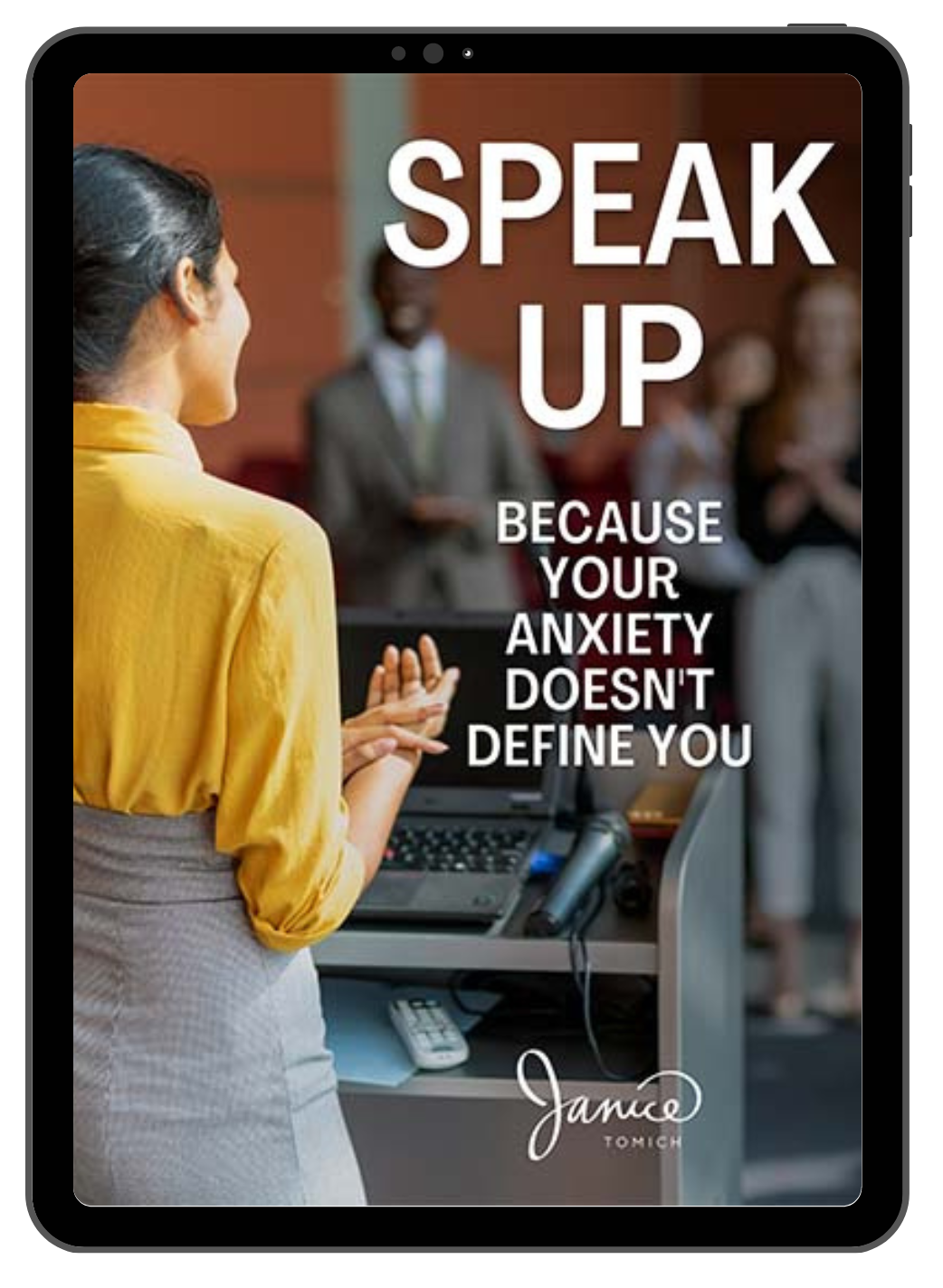Being invited to deliver a keynote address is a great honor.
It’s exhilarating. A compliment to your expertise.
I’m a public speaking coach. A client of mine recently was asked to deliver the keynote address at a large women’s tech event. She was new to public speaking. This was her first high-stakes conference opportunity.
She’s a seasoned leader in an industry with few female colleagues. Although she loves her job, at times her career has been rough. The conference organizers asked her to share her perspective with young women new to the field to help them navigate the inevitable difficulties of being a woman in tech—and also give them advice on how to enjoy the ride.
Her excitement and nervousness were palpable. That’s how it feels when you’re asked to give the keynote.
Being asked means that others value your ideas, thoughts, and vision. You know it’s a big opportunity. A keynote speech provides an opportunity to inspire others like no other.
But if you’ve been asked to share what you’ve experienced throughout your career (or even lifetime) it can be a daunting ask.
With the honor of delivering a keynote comes the responsibility to deliver an address that will inspire your audience to take action.
Table of Contents
What Is a Keynote Speech?
A keynote speech stands above other public speaking opportunities because event organizers make it the highlight of the agenda. Large events often leverage the keynote speaker to attract attendees.
The theme of a keynote is usually set by the event’s theme.
For multi-day events like conferences the keynote is often (but not always) scheduled on the last day. Scheduling the keynote for the end of the event builds excitement and anticipation. Other times the keynote is scheduled near the beginning of an event, and in this case the role of the keynote speaker is to set the tone. Knowing when you’ll be speaking (at the beginning or at the end of the event) impacts the type of keynote speech you should create.
A keynote speaker is usually given a substantial amount of time to speak, often 45 to 60 minutes over dinner. Unlike a shorter presentation, keynote addresses give you a brilliant opportunity to go deep. TO show the breadth of your expertise. To invite your audience along through the ups and downs, ins and outs of a storyline. Your speech can be complex and include unanticipated twists and turns (while of course staying on track with your core message.)
If you’re lost and unsure about how to make your presentation compelling, I can help.
How Long Should A Keynote Be?
There are only a few hard and fast rules about the length of a keynote speech:
- The length of the speech is ultimately dictated by the amount of speaking time allocated by the event organizer.
- The length of the speech should be however long it takes you to clearly and concisely deliver a speech that inspires your audience.
Essentially, just enough time and not too much.
Pro Tip: The amount of time allocated by the organizers is not always set in stone, especially in the early days of organizing an event. Keep the line of communication open with your organizer. The time frame might be open to adjustment or negotiation.
What Makes a Keynote Speech Compelling and Memorable?

An engaging, inspiring keynote presentation encourages the audience to envision what they are capable of. The best keynote speeches don’t just inform—they compel the audience to take action.
Keep two things top of mind as you plan:
- Focus on one main message (your throughline).
- Put yourself in the hearts and minds of your audience. Think of this as a research project as much as an exercise in empathy. Take the time to learn about what your audience wants to know. Learn how they need to hear it.
Going back to my example, the key message of my client who keynoted at the tech conference was resilience.
How did this key message turn into a speech?
She told funny, heart-wrenching stories, including some stories which were excruciating for her at the time they happened. These stories showed her drive to succeed. She spoke candidly about the problems she had come up against in her career. Then she revealed how she solved these problems and the benefits that transpired. Throughout the whole speech, she tapped back into her key message— resilience.
How Much Time Should You Devote to Preparation?
More time than you think.
I have never had a client tell me, “I wish I had spent less time preparing my keynote.”
They’re always glad they invested a good amount of time. Feeling completely ready in the days leading up to the event is worth it.
Nancy Duarte, the author of Resonate, works with industry giants on their keynote speeches. Duarte recommends you spend 30 hours on content creation for a 1-hour speech. (This doesn’t include building the slide deck or practicing the speech).
Here’s my breakdown of the time it takes to be fully prepared to step on stage to deliver your keynote address:
- 30 hours to research your speech and develop the keynote content
- 30 hours to create your keynote slide deck
- 30 hours of practicing your delivery
90 hours likely seems like a lot of time, but that’s what it takes to create and develop an inspirational, career-boosting keynote.
Your first rough draft will be just that … rough. Keynote speech writing is never a one-and-done process. To really nail it you need to get feedback and let the speech, slide deck, and delivery evolve over time. The results are worth it.
How Much Lead Time Do You Need?
Keynotes are a rich opportunity to give an audience perspective into who you are and what you know.
You should allow for 3 months (and a minimum of 2 months) of lead time before you deliver your keynote.
However, life does not always go according to plan. You may not have a lot of time left to prepare. I offer a presentation coaching service called Crunch Time for when you’ve been asked on short notice (a speaker may have become ill) or you have been consumed with other projects and need support to deliver an engaging speech.
Planning a Keynote Speech: Who is your audience? What is your intention?

Your goal should be to take your body of work and experience and use that to resonate with your audience. Inspire them to action. Your words of wisdom will become part of their life experience and create a legacy which will stick with them for years.
“It’s all about the audience—not about you.” These are wise words I’ve never forgotten, delivered to us on the first day of class of my communication degree.
In my work supporting clients through presentation planning, I’m always checking in to ensure that the audience will be able to understand What’s In It For Them (WIIFT in marketing terms). Remembering to center on WIIFT is crucial. It’s the foundation for a successful keynote.
Your intention is important too—equally important, actually. Why are you giving the keynote? What do you want to have happen because of it? Knowing your own “why” and how it relates to the needs of your audience puts you on track to engage and inspire.
How To Write A Keynote Speech
1. Establish your throughline
After you have a good understanding of who your audience is and what your intention is in delivering your keynote it’s time to establish your throughline. Identify which theme or concept you want to speak about.
My client who was keynoting the tech conference planned to speak on resiliency, which is a broad topic. I encouraged her to dig deeper. Upon reflection, she realized that much of her success stemmed from her commitment to creating and building relationships.
She evolved the throughline. The theme of the keynote became developing resiliency through relationships.
2. Brainstorm with an open mind and big wall
Once you’ve decided on your throughline it’s time to find an open wall and a stack of post-it notes.
In freewriting-mode write down any and all ideas that come bubbling up that will support your theme. Take lots of breaks. I promise you’ll come back with fresh ideas each time.
3. Step back and group ideas into themes
Stand back once your wall is filled with ideas. Notice common themes. Place similar ideas into three groups.
What you see is three arguments or points of proof that support your throughline.
4. Pare down to the best ideas
Now sweep through and dispense of any of your ideas that strike you as weak or you don’t feel passionate about.
5. Order your ideas
Place the ideas that remain into a logical order, so that they flow from one idea to the next. That’s your outline. Transfer these concepts to a Google Doc or put pen to paper. You’ve got the bones of a good keynote speech already.
Don’t write out a script word-for-word. Instead, think about what you want to speak about for each of your points. Flesh them out, making notes about what you want to say.
You’ve invested a large amount of time creating the content. Every component of a keynote is important. So now let’s focus on how you open, close, and title your keynote.
How To Open A Keynote Speech
I suspect you’ve been to at least a few presentations where you felt bored by the speaker after just a few minutes.
Too many speakers begin with a status quo opening such as citing their CV or meticulously outlining what they “want to talk with you about.”
You can do better.
My client started her keynote off with a dose of humor rooted in her own personal experience. She talked about the inappropriate clothes she wore to an interview and the hilarious story of what she did to gain access to the building.
Here are a few more ideas to open your keynote speech:
- Start your speech by addressing the elephant in the room to address a negative bias your audience may be thinking. Perhaps you are quite young and your audience is older. You could begin by saying, “You are probably looking at me thinking she’s twelve years old and what could she know. And you’d be right…”
- Quote a startling statistic. Often keynotes focus on living out dreams. This statement will have your audience’s interest piqued, “The average person has over 1,460 dreams a year”.
- Begin a story that you can use to weave and thread your presentation together. You could begin by sharing a story of how a mentor helped. Throughout your presentation continue the story dropping the nuggets of wisdom of what your mentor said and how she helped.
It’s crucial that you grab your audience’s attention right from the start – that you hook them with your first words.
How To Close a Keynote Speech
Finish your keynote with clarity and power. I’ve listened to too many speeches and keynotes where the ending was weak. They didn’t live up to the energy of the body of work.
My client decided to loop back to the chain of events that happened before her interview, narrating how she hung in there, even when things weren’t going according to plan.
Here are some excellent approaches to closing your keynote powerfully:
Loop back to how you began your speech. If you began your speech by talking about the elephant in the room, tag back to provide assurance that you have.
Wrap up a story you teased in your opening and then threaded throughout the speech.
If you began your keynote with a stat or quote reference it again at the end by summarizing how you proved it was true.
A tenet I firmly stand by that it’s not good enough to just leave your audience inspired. You must leave them inspired to do something. Close your speech with a clear call to action to do something tangible that will make a difference to them and/or their community.
Choosing a Title for Your Keynote
Your title is your audience’s first introduction to what they will hear. Finding the ‘right’ title makes them want to listen.
If a compelling title comes to mind before or as you are developing and creating your speech, write it down. But don’t worry if you’ve planned out your whole speech and still don’t have a title idea. The best titles often come to us right at the end. You’ll have lots of ideas to play with when you’ve finished gathering your content.
Here is a trick while working with an editor at Inc.com: first craft a title, then play with variations of that title by using words that will get attention or have an inherent hook embedded within them.
Here’s an example of how I played with titles before settling on one for this article:
My initial ideas were
“How To Write an Engaging Keynote” or “How To Write a Compelling Keynote”
Both titles are merely functional. They’re lackluster and don’t reflect the complexity of the article itself, which goes beyond merely “writing” a keynote.
I rephrased it to expand on the topic and add a bit more punch:
“How to Plan, Write, and Deliver an Exciting Keynote Speech”
Better, but I knew I could do better.
“Guide To Planning, Writing, and Delivering a Killer Keynote Speech”
I liked it. It is more eye catching and it indicates a comprehensive “guide” that promises not just a “how to” article, but in-depth advice that speaks to creating an excellent keynote that will be well received.
Invest the time in finding just the right title. It’s worth it. It piques your audience’s interest from their first interaction with you.
How To Practice Your Keynote Speech

Don’t put off practicing until the last minute. Conversely, don’t over-practice until you sound like a robot and have diluted every ounce of passion out of your presentation.
Making good use of your practice time is easy.
I’ve written an extensive guide on how to rehearse for a presentation and I’ve also written on this topic for Inc.com. Read them for tips and techniques to learn your keynote speech easily so you can walk on the stage confidently knowing you’ll nail it.
I have never had a client tell me they wished they had practiced less. I encourage you to practice only as much as you need to and not a second more.
Pro Tip: When you have a few spots that are giving you difficulties just practice those sections. It’s a poor investment of your time to practice your keynote over and over in its entirety if only a few sections are tripping you up.
Tips For Creating Your Slidedeck or PowerPoint Presentation
My take on PowerPoint is that it’s a powerful tool that has been dropped into the laps of people who, more often than not, don’t have the training or experience to wield it effectively.
Before PowerPoint, marketing and communication teams would strategize over the best content for the slides. Graphic designers would create them.
These are the three most important things to know about your slide presentation:
These are the three most important things to know about your slide presentation:
- If slides won’t add or support your presentation don’t use them.
- Create your slides so that they are primarily image-based with a limited amount of text.
- If you are not a graphic designer hire one. It’s worth it for the stroke of elegance and professional edge they will add. A graphic designer will bring your deck to life.

If you do decide to use a slidedeck ensure it helps your audience connect the dots and visualize what you are sharing with them.
What To Do Before You Deliver Your Speech
I’m often backstage supporting clients at their events. It’s exhilarating to feel the energy of speakers waiting to go on stage. You can feel the excitement … hearts pounding and voices warming up.
Here are a few tips and techniques professional speakers use to ready themselves, calm their nerves, and warm up their voice before giving a keynote speech:
- If you find yourself not sleeping well or experiencing anxiety in the days leading up to your speech try 4 – 7 – 8 breathing. Three or four rounds should have you feeling calmer and able to fall back to sleep.
- Keep yourself hydrated. The day before your event up your water intake. This will keep you feeling energetic and your voice lubricated.
- Make sure you get a good sleep before your keynote. Lack of sleep will knock you off your game.
- Fifteen minutes before your keynote move your voice up and down through your natural register with vocal exercises so you can use your voice like the fine instrument it is.
- Just as you are about to speak, if you suffer from dry mouth, take these lozenges to help you articulate with ease.
- When you arrive at the podium take a few deep breaths, feel your feet on the floor, touch a favourite amulet such as a ring or necklace…and away you go!
What You Should Do After Your Speech
When you end your speech you’re still not quite finished yet.
Connect with people from your audience. Gather feedback. Some of the richest relationships you will create will happen if you take the time to talk with people after your speaking event. If you have the opportunity, ask for presentation feedback to help you learn what worked and what didn’t.

Don’t ask if they enjoyed your keynote because the response will probably be, “It was great!” Instead, ask what they took away that will make a difference in their life. Ask them what nugget stuck with them. The answers to these questions will provide information to improve your next keynote.
Having your keynote recorded provides a brilliant learning opportunity. Many of my clients tell me they can’t/won’t watch a recording of themselves. I ask them to separate themselves from their egos and embrace the opportunity to learn. You can gain insight into what landed and what didn’t by your audience’s reactions.
Ask for presentation feedback from a trusted advisor. Don’t ask family and friends. A trusted advisor or mentor has the perspective to provide unbiased feedback that your family and friends won’t be able to. A trusted advisor will be able to expertly able to weigh in about your content, your delivery, and the effectiveness of your speech. ¯
Keynote speeches are complex. They have lots of pieces that need to fit together to create an easy, simple flow and to hold your audience in your hands so they will be inspired and learn from you.
Do you need help with your upcoming keynote speech to make sure your audience will leave challenged to take action and be inspired? I have a public speaking coach package that’s perfect keynote speeches.


